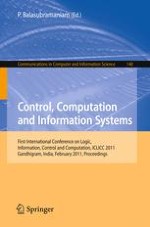2011 | Book
Control, Computation and Information Systems
First International Conference on Logic, Information, Control and Computation, ICLICC 2011, Gandhigram, India, February 25-27, 2011. Proceedings
Editor: P. Balasubramaniam
Publisher: Springer Berlin Heidelberg
Book Series : Communications in Computer and Information Science
